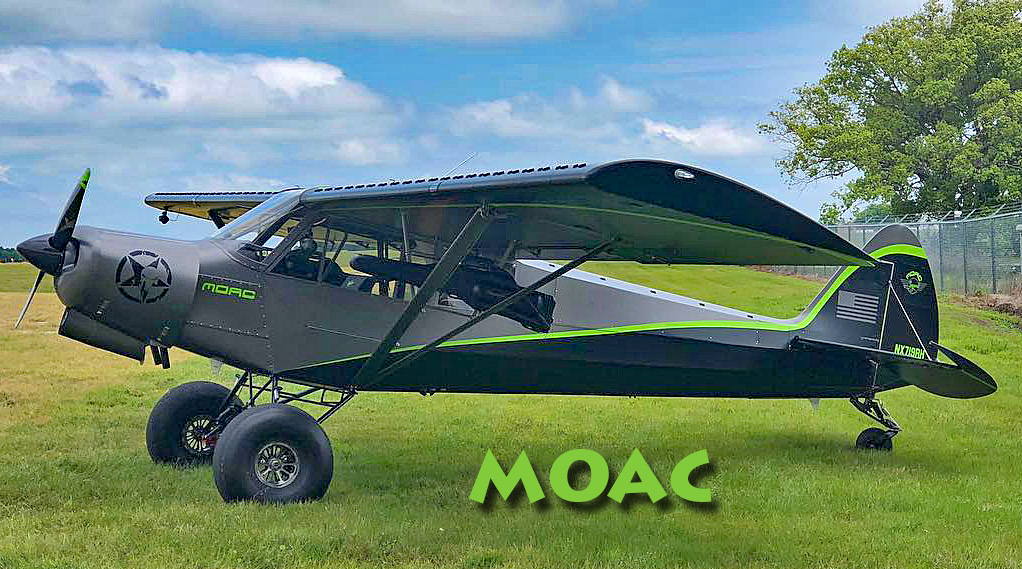
Sun ‘n Fun is over. While staff, tent vendors and more have plenty of work to do, customers and vendors have all vacated the area, scattering off across the USA as they return to base. Some have a new airplane. Numerous vendors reported solid sales during the show. Pilots liked what they saw and a good economy is powering activity. I will follow up with a show summary soon. Following I have three more short stories. However, watch for dozens of new videos from Light Sport and Ultralight Flyer on YouTube and I will have further reporting from material gathered at Sun ‘n Fun 2019. MOAC — “Tweety” got mine and lots of well-deserved attention (photo), being the very first airplane American Legend produced, back in 2005. The original aircraft was on display at Sun ‘n Fun. Since the company has since registered 226 aircraft, Tweety launched quite a good run.


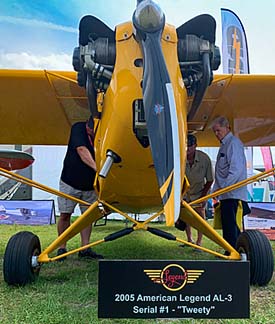 Sun 'n Fun is over. While staff, tent vendors and more have plenty of work to do, customers and vendors have all vacated the area, scattering off across the USA as they return to base.
Some have a new airplane. Numerous vendors reported solid sales during the show. Pilots liked what they saw and a good economy is powering activity. I will follow up with a show summary soon.
Following I have three more short stories. However, watch for dozens of new videos from Light Sport and Ultralight Flyer on
Sun 'n Fun is over. While staff, tent vendors and more have plenty of work to do, customers and vendors have all vacated the area, scattering off across the USA as they return to base.
Some have a new airplane. Numerous vendors reported solid sales during the show. Pilots liked what they saw and a good economy is powering activity. I will follow up with a show summary soon.
Following I have three more short stories. However, watch for dozens of new videos from Light Sport and Ultralight Flyer on 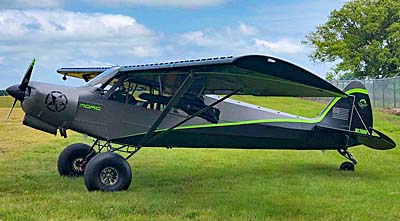 However, it was the Mother Of All Cubs that commandeered the focus of many show attendees visiting the American Legend exhibit. This variation on their theme has several wow factors.
A handsome young fellow sat in the airplane as I approached. He turned out to be Luke, son of American Legend boss, Darin Hart. I looked again to see he was seated in the third seat. A strut maintains structure in front of the third seat but it removes easily with quick pins. Luke scrambled out of the third seat easily. "It's actually easier than entering the front seat of MOAC," said Luke.
Those seats do more. They can fold forward and with some securing anchors, can haul a different payload. The seating ties in with a whole new "turtle deck" as Darin called it. Not your usual turtle deck, this six-foot-long opening runs from the trailing edge of the wing halfway to the tail. The turtle deck opens wide enough to allow an injured passenger to be loaded head first into MOAC.
For three persons or an air ambulance, MOAC has plenty of power to carry about 1,000 pounds of useful load thanks to the largest Titan X370 producing 195 horsepower. Darin said climb performance is so strong, he plans to enter three AOPA regional event STOL competitions and believes MOAC can do well. "It's pretty easy to manage the takeoff to win," Darin noted. "It's landing really short that demands high pilot skills,"
However, it was the Mother Of All Cubs that commandeered the focus of many show attendees visiting the American Legend exhibit. This variation on their theme has several wow factors.
A handsome young fellow sat in the airplane as I approached. He turned out to be Luke, son of American Legend boss, Darin Hart. I looked again to see he was seated in the third seat. A strut maintains structure in front of the third seat but it removes easily with quick pins. Luke scrambled out of the third seat easily. "It's actually easier than entering the front seat of MOAC," said Luke.
Those seats do more. They can fold forward and with some securing anchors, can haul a different payload. The seating ties in with a whole new "turtle deck" as Darin called it. Not your usual turtle deck, this six-foot-long opening runs from the trailing edge of the wing halfway to the tail. The turtle deck opens wide enough to allow an injured passenger to be loaded head first into MOAC.
For three persons or an air ambulance, MOAC has plenty of power to carry about 1,000 pounds of useful load thanks to the largest Titan X370 producing 195 horsepower. Darin said climb performance is so strong, he plans to enter three AOPA regional event STOL competitions and believes MOAC can do well. "It's pretty easy to manage the takeoff to win," Darin noted. "It's landing really short that demands high pilot skills,"
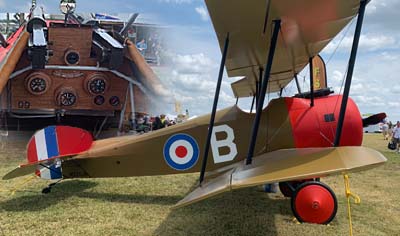 The movie people saw the precision of his replicas. These are vintage aircraft built as closely as possible to their original but using modern materials and techniques. Under the authentic looking exterior is a welded steel frame. Aerodrome supplies these elements for kit builders. Movie studios may stimulate a design, by Baslee's creations have also enabled a following that loves the vintage look.
Of course, the guns in front of the pilot were not real …but they looked it. British military engineers invented a mechanical system to stop the guns from firing when a propeller blade was passing in front of the barrel.
See their whole flock in this
The movie people saw the precision of his replicas. These are vintage aircraft built as closely as possible to their original but using modern materials and techniques. Under the authentic looking exterior is a welded steel frame. Aerodrome supplies these elements for kit builders. Movie studios may stimulate a design, by Baslee's creations have also enabled a following that loves the vintage look.
Of course, the guns in front of the pilot were not real …but they looked it. British military engineers invented a mechanical system to stop the guns from firing when a propeller blade was passing in front of the barrel.
See their whole flock in this 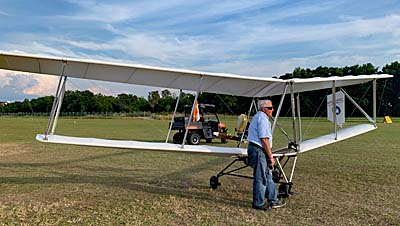 At Sun 'n Fun, as he has so often done, John flew an Easy Riser much like his original from 45 years ago. A mere 15 horsepower, shifting weight fore and aft to change pitch, no landing gear, no instrumentation needed.
John developed an airshow routine where, for example, an angry bill collector so badly wants to bring down John that he comes to the airfield with his shotgun. Bang! A shot is fired. Off drops one of John's wheels! Bang, bang! Two more are gone and John's plane no longer has any landing gear. How will he land, the crowd wonders? No problem, as he'd swoop down and smoothly touch down using only his legs. These days John uses his full-castoring undercarriage so he no longer needs to land on his feet.
Landing gear or legs, it is always inspiring to see John fly. He typically joins in when the powered paragliders fly at the end of the evening when winds calm.
Ah,
At Sun 'n Fun, as he has so often done, John flew an Easy Riser much like his original from 45 years ago. A mere 15 horsepower, shifting weight fore and aft to change pitch, no landing gear, no instrumentation needed.
John developed an airshow routine where, for example, an angry bill collector so badly wants to bring down John that he comes to the airfield with his shotgun. Bang! A shot is fired. Off drops one of John's wheels! Bang, bang! Two more are gone and John's plane no longer has any landing gear. How will he land, the crowd wonders? No problem, as he'd swoop down and smoothly touch down using only his legs. These days John uses his full-castoring undercarriage so he no longer needs to land on his feet.
Landing gear or legs, it is always inspiring to see John fly. He typically joins in when the powered paragliders fly at the end of the evening when winds calm.
Ah, 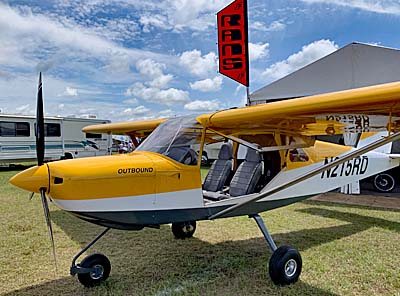 Sun 'n Fun streaks on with Blue Angels and Stearmans cracking the air. Exhibits are active. People are shopping for the right airplane. Strong crowds were present at peak times. Opening day may have set a record. Generally vendors and customers seemed to be in good spirits. Recreational aviation looks healthy.
As I spoke with vendors, one comment I heard repeatedly — freely offered but never requested — was "The economy is good. People have money to spend." This statement came up often enough to give it weight.
Those of you shopping at home can have a little fun with
Sun 'n Fun streaks on with Blue Angels and Stearmans cracking the air. Exhibits are active. People are shopping for the right airplane. Strong crowds were present at peak times. Opening day may have set a record. Generally vendors and customers seemed to be in good spirits. Recreational aviation looks healthy.
As I spoke with vendors, one comment I heard repeatedly — freely offered but never requested — was "The economy is good. People have money to spend." This statement came up often enough to give it weight.
Those of you shopping at home can have a little fun with  The trouble is, for the last two generations of pilots, nearly all were instructed in a tricycle gear airplane. Most have also heard stories about ground loops causing damage and hurting pride. They stick to tricycle gear and given their training, that's probably appropriate. For Sun 'n Fun 2019, Rans brought Outbound in tricycle gear. Despite what many might have expected the configuration looks good.
The nose wheel doesn't affect handling or performance; "it flies the same as the tail dragger," said Randy Schlitter.
Outbound can be powered by a Rotax 912 with 100 horsepower or up to a Titan X340 with 180 horsepower. Randy said the climb with the bigger engine is impressive (850 to 1,500 fpm) but fuel usage rises noticeably (from 5.5 to 7 gph, and pilot real-life experience may result an even greater gap). Takeoff is also fast with the big engine: just over 300 feet to leave the runway and just under 400 to land …in skilled hands, of course. However, interestingly Rans quotes essentially the same launch and landing values for the Rotax 912.
The trouble is, for the last two generations of pilots, nearly all were instructed in a tricycle gear airplane. Most have also heard stories about ground loops causing damage and hurting pride. They stick to tricycle gear and given their training, that's probably appropriate. For Sun 'n Fun 2019, Rans brought Outbound in tricycle gear. Despite what many might have expected the configuration looks good.
The nose wheel doesn't affect handling or performance; "it flies the same as the tail dragger," said Randy Schlitter.
Outbound can be powered by a Rotax 912 with 100 horsepower or up to a Titan X340 with 180 horsepower. Randy said the climb with the bigger engine is impressive (850 to 1,500 fpm) but fuel usage rises noticeably (from 5.5 to 7 gph, and pilot real-life experience may result an even greater gap). Takeoff is also fast with the big engine: just over 300 feet to leave the runway and just under 400 to land …in skilled hands, of course. However, interestingly Rans quotes essentially the same launch and landing values for the Rotax 912.
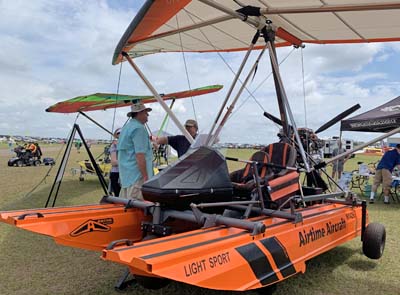 With the tricycle gear, you can have robust but smaller tires or you can opt for the tricycle version of bush gear; doing so gives greater prop clearance for larger diameters. All outbounds can go both ways, taildragger or tri-gear. It takes about four hours to swap out the hardware but the airframe is built to accommodate either configuration.
With the tricycle gear, you can have robust but smaller tires or you can opt for the tricycle version of bush gear; doing so gives greater prop clearance for larger diameters. All outbounds can go both ways, taildragger or tri-gear. It takes about four hours to swap out the hardware but the airframe is built to accommodate either configuration.
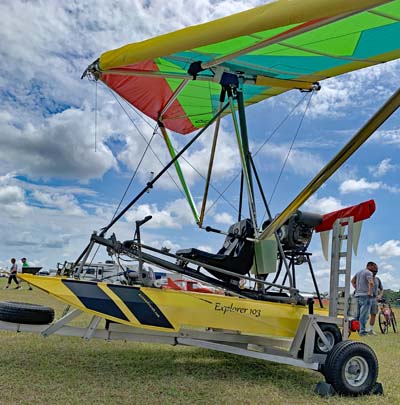 Airtime has the trike carriage attached optimally to the floats to complement this quality of trikes and the results are good. I watched as Michael cycled the gear up and down (look for a mini video as soon as I find time). It's a remarkably fast moving system and appears very simple. This system is used in two configurations on both the company's aircraft.
Airtime Aircraft offers two trike models. One is the Cygnet that
Airtime has the trike carriage attached optimally to the floats to complement this quality of trikes and the results are good. I watched as Michael cycled the gear up and down (look for a mini video as soon as I find time). It's a remarkably fast moving system and appears very simple. This system is used in two configurations on both the company's aircraft.
Airtime Aircraft offers two trike models. One is the Cygnet that 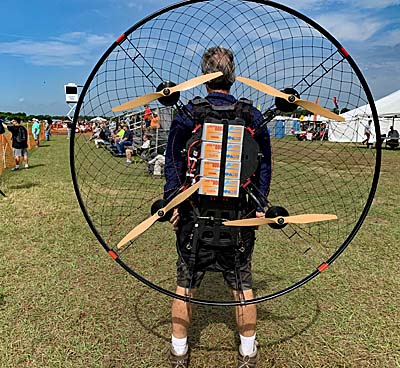 I learned of this from
I learned of this from 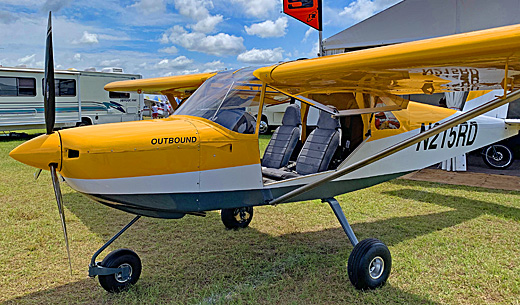
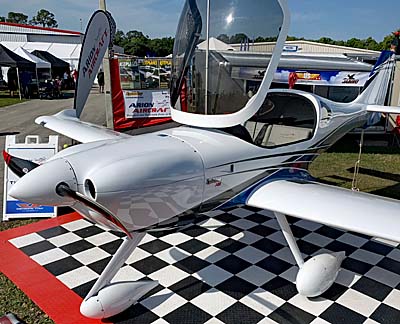 Now, ultralight pilots (me, for instance) will go on enthusiastically about the beauty of flying slowly, of drifting leisurely over the landscape at a "human speed" that allows enough time to enjoy the expanse of an aerial view of your surroundings. Open cockpit flying adds to the joy facilitated by low airspeeds.
Yet the allure of going fast is great, zipping over the countryside. I get that and when contemplating a cross country trip of any real distance, fast cannot be too fast. In addition to a higher TAS, we all yearn for a tailwind that will raise our speed by another 20 mph.
Now, ultralight pilots (me, for instance) will go on enthusiastically about the beauty of flying slowly, of drifting leisurely over the landscape at a "human speed" that allows enough time to enjoy the expanse of an aerial view of your surroundings. Open cockpit flying adds to the joy facilitated by low airspeeds.
Yet the allure of going fast is great, zipping over the countryside. I get that and when contemplating a cross country trip of any real distance, fast cannot be too fast. In addition to a higher TAS, we all yearn for a tailwind that will raise our speed by another 20 mph.
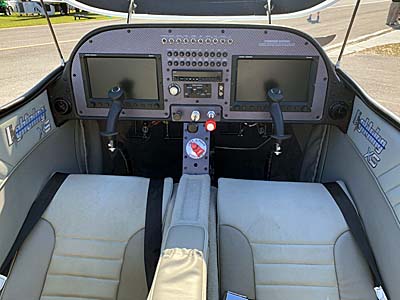 Lightning has enjoyed and continues to execute a good run but like many designers, Nick felt the design could handle more speed. He set out to bump the numbers by installing a Titan X340 with 180 horsepower. This triggered other changes such as a new cowl to accommodate the powerplant.
"Our Lightning XS kit has a redesigned forward fuselage structure that gives the builder the option to choose engines up to 180 horsepower," said Nick. "Taller landing gear for bigger props, bigger brakes, and 20 gallon fuel tanks are among some of the features of this new kit."
How fast does Lightning XS go? Testing is not complete yet; it recently took to the air. However, Arion is calculating 165 knots (190 mph) TAS at 8,500 feet density altitude at full gross. Climb is a stunning 2,000 fpm.
Of course Lightning XS is not a Light-Sport Aircraft and will require a Private or better certificate plus a medical.
Lightning has enjoyed and continues to execute a good run but like many designers, Nick felt the design could handle more speed. He set out to bump the numbers by installing a Titan X340 with 180 horsepower. This triggered other changes such as a new cowl to accommodate the powerplant.
"Our Lightning XS kit has a redesigned forward fuselage structure that gives the builder the option to choose engines up to 180 horsepower," said Nick. "Taller landing gear for bigger props, bigger brakes, and 20 gallon fuel tanks are among some of the features of this new kit."
How fast does Lightning XS go? Testing is not complete yet; it recently took to the air. However, Arion is calculating 165 knots (190 mph) TAS at 8,500 feet density altitude at full gross. Climb is a stunning 2,000 fpm.
Of course Lightning XS is not a Light-Sport Aircraft and will require a Private or better certificate plus a medical.
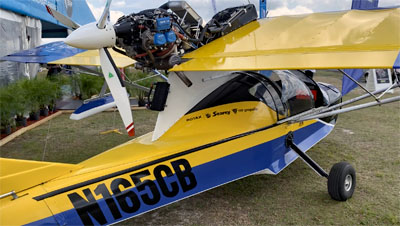
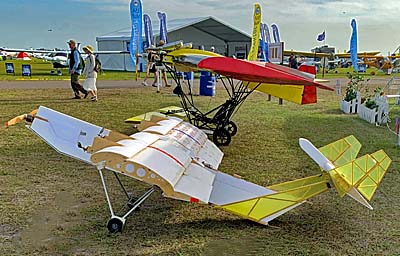 Brian's last full-sized project, the
Brian's last full-sized project, the 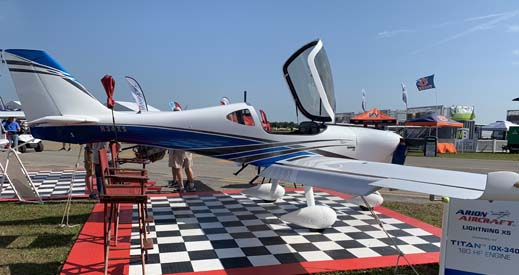
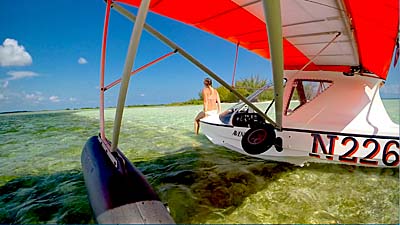
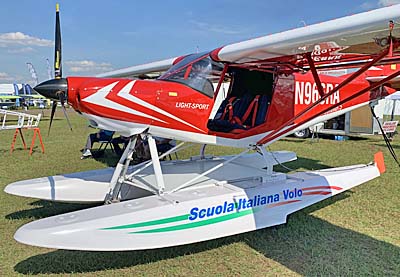
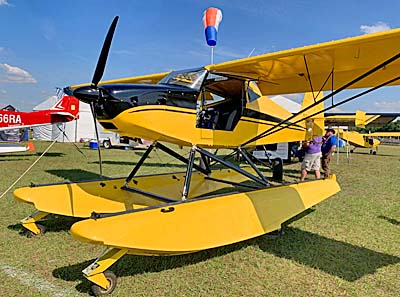

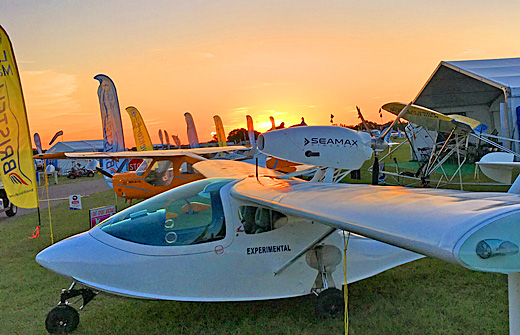
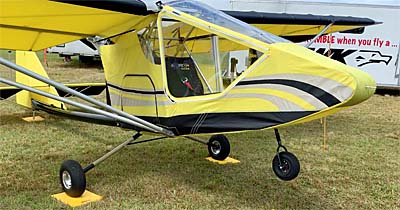
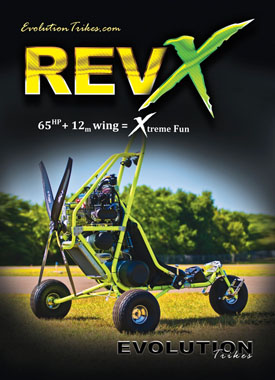

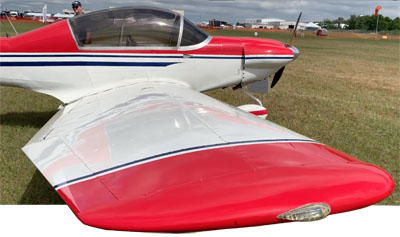
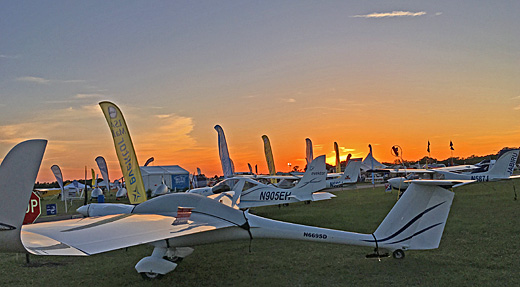
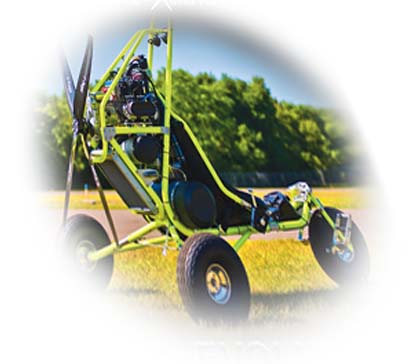
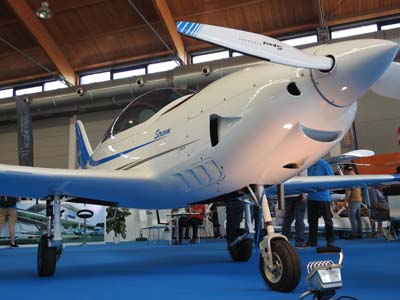 Welcome to Stream, a carbon fiber, low wing, tandem seating, retractable gear lightplane. Stream is clearly part of the TL family but is completely different than the preceding two models — that Americans already know.
Sting has been their lead example through four iterations of the sleek low wing design: Sting-S2-S3-S4. Years ago Sting was offered with retractable gear but then came Light-Sport Aircraft rules so fixed gear became the norm. Later came the similarly built but high wing, yoke-controlled Sirius. Now, Stream…
Welcome to Stream, a carbon fiber, low wing, tandem seating, retractable gear lightplane. Stream is clearly part of the TL family but is completely different than the preceding two models — that Americans already know.
Sting has been their lead example through four iterations of the sleek low wing design: Sting-S2-S3-S4. Years ago Sting was offered with retractable gear but then came Light-Sport Aircraft rules so fixed gear became the norm. Later came the similarly built but high wing, yoke-controlled Sirius. Now, Stream…
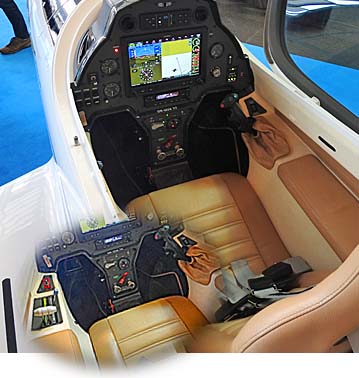 The U.S. based company, with roots in the origin country of Czech Republic, is displaying a Sting, a turbo Sting, the company's high wing Sirius, and Stream. The example was built as it must be for the American market as an Experimental Amateur Built model. A husband and wife team just return from a month in Czech Republic where they fulfilled all requirements for FAA approval. It is their airplane on display.
The U.S. based company, with roots in the origin country of Czech Republic, is displaying a Sting, a turbo Sting, the company's high wing Sirius, and Stream. The example was built as it must be for the American market as an Experimental Amateur Built model. A husband and wife team just return from a month in Czech Republic where they fulfilled all requirements for FAA approval. It is their airplane on display.

 Most Americans know the childhood story about the "Little Engine that Could," a tale of determination, working against long odds and succeeding despite them. I think that relates to SeaMax.
Visually, SeaMax looks small, low, and compact compared to some LSA seaplanes. Taking nothing away from the others, SeaMax appears ready to fill a need for something sportier, speedier. Despite its small size, SeaMax delivers comfort and capability.
Learn more in my flight evaluation video below, but at
Most Americans know the childhood story about the "Little Engine that Could," a tale of determination, working against long odds and succeeding despite them. I think that relates to SeaMax.
Visually, SeaMax looks small, low, and compact compared to some LSA seaplanes. Taking nothing away from the others, SeaMax appears ready to fill a need for something sportier, speedier. Despite its small size, SeaMax delivers comfort and capability.
Learn more in my flight evaluation video below, but at 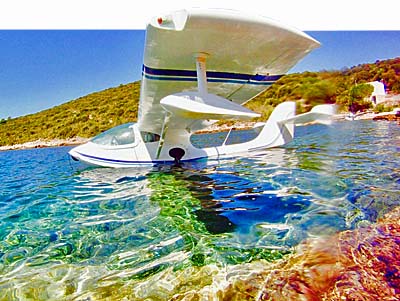 Perhaps even more important,
Perhaps even more important, 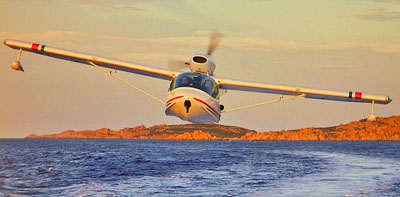 The Brazilian company, with
The Brazilian company, with 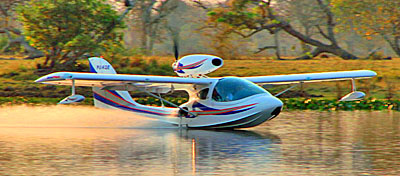 For those who cannot attend Sun 'n Fun 2019, the company has a permanent aircraft in south Florida where it can offer introductory flights to customers.
Beyond intro flights, SeaMax is now offering a transition training program for interested customers. When a customer purchases a new SeaMax at Sun 'n Fun 2019, the customer will get a 10-hour training program for free. That's a good deal and the full training will help you gain familiarity with SeaMax.
In production since 2001, SeaMax M-22 has delivered over 150 units that are flying in more than 20 countries. The company is presently taking orders for delivery in the third quarter of 2019.
Learn more about SeaMax in this Video Pilot Report from DeLand 2018:
https://youtu.be/ufO95UbOwbc
For those who cannot attend Sun 'n Fun 2019, the company has a permanent aircraft in south Florida where it can offer introductory flights to customers.
Beyond intro flights, SeaMax is now offering a transition training program for interested customers. When a customer purchases a new SeaMax at Sun 'n Fun 2019, the customer will get a 10-hour training program for free. That's a good deal and the full training will help you gain familiarity with SeaMax.
In production since 2001, SeaMax M-22 has delivered over 150 units that are flying in more than 20 countries. The company is presently taking orders for delivery in the third quarter of 2019.
Learn more about SeaMax in this Video Pilot Report from DeLand 2018:
https://youtu.be/ufO95UbOwbc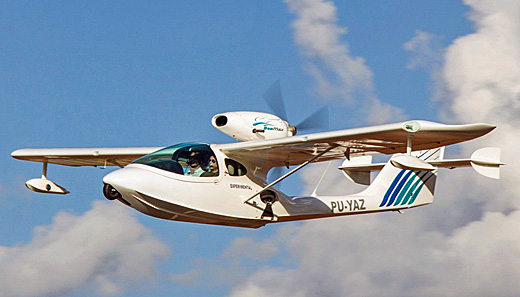
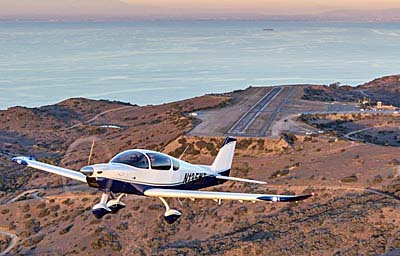 Intended Departure: Sunday at 4 AM Pacific • Landing Florida before 7 PM Eastern in a flight forecast to take "under 12 hours" at a predicted speed of 160 knots (184 mph), at altitude.
You can track the flight on
Intended Departure: Sunday at 4 AM Pacific • Landing Florida before 7 PM Eastern in a flight forecast to take "under 12 hours" at a predicted speed of 160 knots (184 mph), at altitude.
You can track the flight on 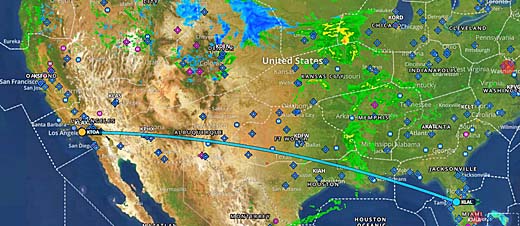 Sling TSi has standard tanks of 45 gallons capacity or optional long-range wing tip tanks that add an additional 22 gallons plus an internal portable tanks of 20 gallons for a grand total of 87 gallons on board.
Visit The Airplane Factory USA at
Sling TSi has standard tanks of 45 gallons capacity or optional long-range wing tip tanks that add an additional 22 gallons plus an internal portable tanks of 20 gallons for a grand total of 87 gallons on board.
Visit The Airplane Factory USA at 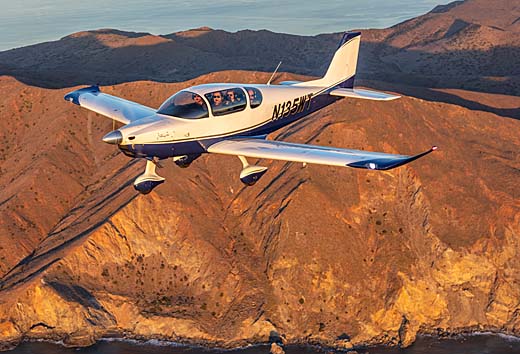
 Let me admit right up front: I am a big fan of AirCam. I have flown several different examples. I have done a flight report in one with boss Phil Lockwood. I even earned my Multi-Engine Rating in one. For a longtime open-cockpit ultralight pilot like me, AirCam may be the ultimate expression of a fun aircraft in which you can do things you shouldn't even consider in most other airplanes.
So, when Phil told me about
Let me admit right up front: I am a big fan of AirCam. I have flown several different examples. I have done a flight report in one with boss Phil Lockwood. I even earned my Multi-Engine Rating in one. For a longtime open-cockpit ultralight pilot like me, AirCam may be the ultimate expression of a fun aircraft in which you can do things you shouldn't even consider in most other airplanes.
So, when Phil told me about 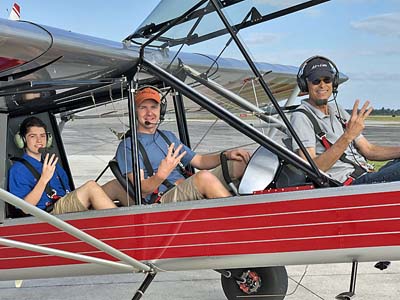 The third seat can be installed in either an open-cockpit AirCam or one with the full enclosure canopy. The canopy — developed some years after AirCam first emerged — was designed from the start to accommodate the third seat.
“Numerous improvements have been incorporated in the new Gen-3 model airframes to accommodate the optional gross weight increase and jump seat,” said Lockwood. “The landing gear has been strengthened to accommodate greater landing and take off weights. Landing gear modifications include new stronger gear legs, a beefed-up fuselage gearbox and upgraded Beringer wheels and brakes.”
Phil Lockwood also reported AirCam’s aft section of the fuselage and tail spring have also been strengthened to accommodate the higher loads. The new fuselage incorporates a new set of foot wells to improve comfort and safety when utilizing the jump seat.
The third seat can be installed in either an open-cockpit AirCam or one with the full enclosure canopy. The canopy — developed some years after AirCam first emerged — was designed from the start to accommodate the third seat.
“Numerous improvements have been incorporated in the new Gen-3 model airframes to accommodate the optional gross weight increase and jump seat,” said Lockwood. “The landing gear has been strengthened to accommodate greater landing and take off weights. Landing gear modifications include new stronger gear legs, a beefed-up fuselage gearbox and upgraded Beringer wheels and brakes.”
Phil Lockwood also reported AirCam’s aft section of the fuselage and tail spring have also been strengthened to accommodate the higher loads. The new fuselage incorporates a new set of foot wells to improve comfort and safety when utilizing the jump seat.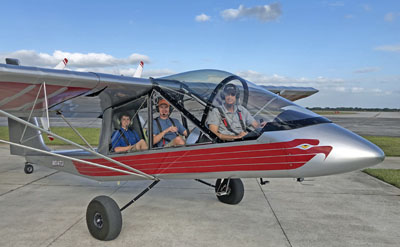 Being Rotax experts known across the country, Lockwood's enterprise was ready to step up the potency of their twin engines.
They've long offered the more powerful turbocharged Rotax 914. Most AirCams, however, work wonderfully well with a pair of the 100-horsepower Rotax 912ULS or 912iS engines. Even more could be better, you might agree.
To provide the additional single engine performance needed for the higher gross weights of AirCam Gen 3 Lockwood Aircraft is offering a new, upgraded 115-horsepower Rotax 912 power package using a “big-bore kit” involving new cylinders and heavier pistons. “Customers opting for the standard 100-horsepower 912 engines will be limited to the original 1,680-pound maximum gross weight,” Lockwood clarified.
Being Rotax experts known across the country, Lockwood's enterprise was ready to step up the potency of their twin engines.
They've long offered the more powerful turbocharged Rotax 914. Most AirCams, however, work wonderfully well with a pair of the 100-horsepower Rotax 912ULS or 912iS engines. Even more could be better, you might agree.
To provide the additional single engine performance needed for the higher gross weights of AirCam Gen 3 Lockwood Aircraft is offering a new, upgraded 115-horsepower Rotax 912 power package using a “big-bore kit” involving new cylinders and heavier pistons. “Customers opting for the standard 100-horsepower 912 engines will be limited to the original 1,680-pound maximum gross weight,” Lockwood clarified.
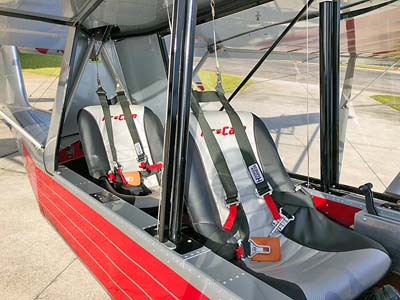 “The additional 15 horsepower per engine is achieved though an increase in displacement with no increase in weight.” Customers may purchase or retrofit either a carbureted 912 ULS or fuel injected 912iS engine package to provide 115-horsepower upgrades for either engine model. Buyers or owners can opt to install the 115-horsepower package at a later date.
What may be exciting for current owners of a 912ULS or iS on another airplane is that this engine upgrade is something you can achieve retroactively. The cost is about $6,000, Phil indicated, but for that money you get a substantial performance boost.
“The additional 15 horsepower per engine is achieved though an increase in displacement with no increase in weight.” Customers may purchase or retrofit either a carbureted 912 ULS or fuel injected 912iS engine package to provide 115-horsepower upgrades for either engine model. Buyers or owners can opt to install the 115-horsepower package at a later date.
What may be exciting for current owners of a 912ULS or iS on another airplane is that this engine upgrade is something you can achieve retroactively. The cost is about $6,000, Phil indicated, but for that money you get a substantial performance boost. 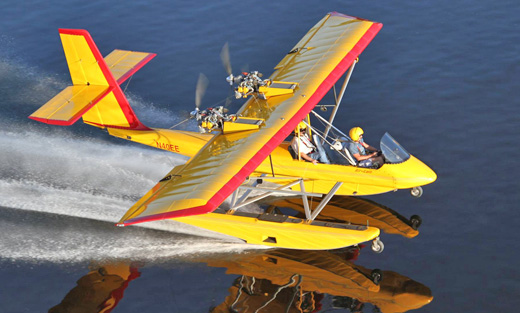
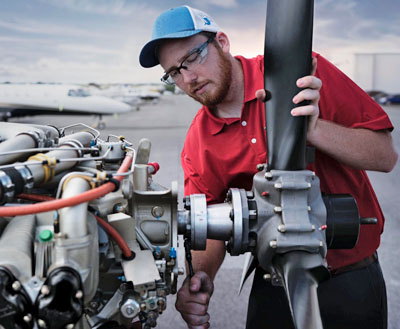 A few years ago, I visited Continental Motors in Mobile Alabama on the Gulf coast of the southern U.S. state.
Here's
A few years ago, I visited Continental Motors in Mobile Alabama on the Gulf coast of the southern U.S. state.
Here's  "With this new dawn comes a new name and brand identity for a major leader in the world of aviation. Introducing Continental Aerospace Technologies," stated their press release.
However, they're busy doing much more than rebadging the company with a new, modern look. Their video below helps tell a fuller story.
"With this new dawn comes a new name and brand identity for a major leader in the world of aviation. Introducing Continental Aerospace Technologies," stated their press release.
However, they're busy doing much more than rebadging the company with a new, modern look. Their video below helps tell a fuller story.
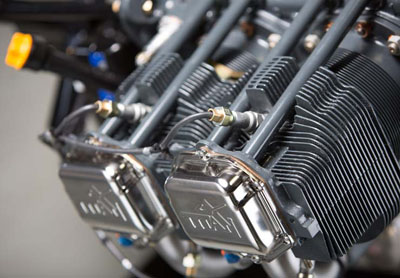
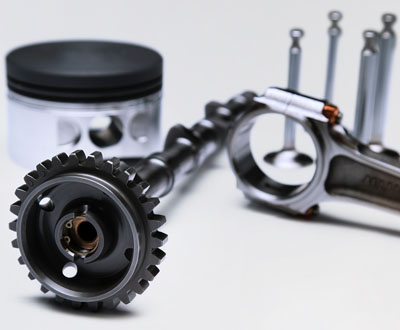
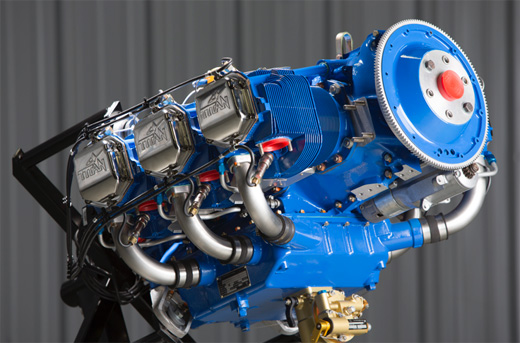
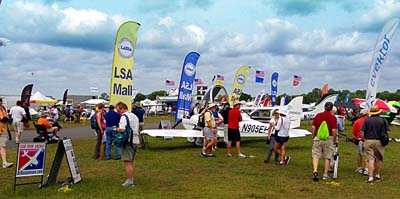 This year celebrates 15 years of Light-Sport Aircraft and its companion pilot certificate, Sport Pilot. This year also celebrates the 12th year of LAMA providing the LSA Mall. What a fascinating ride it has been!
For 2019,
This year celebrates 15 years of Light-Sport Aircraft and its companion pilot certificate, Sport Pilot. This year also celebrates the 12th year of LAMA providing the LSA Mall. What a fascinating ride it has been!
For 2019, 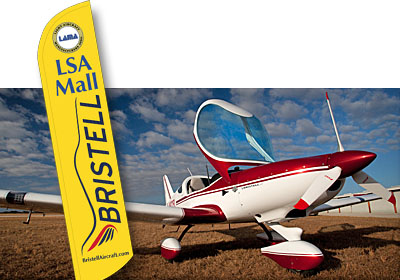 For 2019, the LSA Mall will add a few previously-owned LSA, as this part of the light aircraft market is developing. I've
For 2019, the LSA Mall will add a few previously-owned LSA, as this part of the light aircraft market is developing. I've 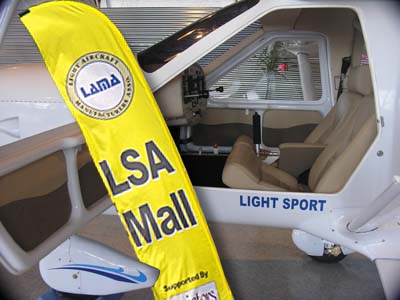 In addition to dozen Light-Sport Aircraft and Sport Pilot kits all parked wingtip-to-wingtip, LAMA will also again host a display of engines used on Light-Sport Aircraft and Sport Pilot kits.
Pilots have a understandable fascination with engines and the display in the LAMA tent at the LSA Mall in Paradise City is the one-and-only place where you can see them all in close proximity to one another.
In addition to dozen Light-Sport Aircraft and Sport Pilot kits all parked wingtip-to-wingtip, LAMA will also again host a display of engines used on Light-Sport Aircraft and Sport Pilot kits.
Pilots have a understandable fascination with engines and the display in the LAMA tent at the LSA Mall in Paradise City is the one-and-only place where you can see them all in close proximity to one another.
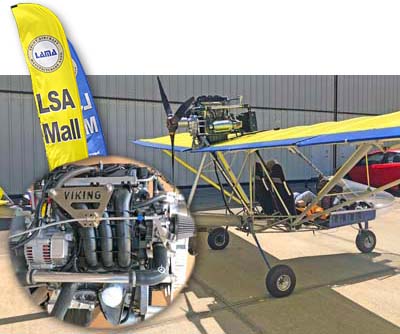 If you visit the core area of Sun 'n Fun, you know it is a fair walk to Paradise City. Yet it is a great draw as many see that Sun 'n Fun's "alternate airport" in Paradise City represents something of an airshow-within-an airshow.
As with AirVenture,
If you visit the core area of Sun 'n Fun, you know it is a fair walk to Paradise City. Yet it is a great draw as many see that Sun 'n Fun's "alternate airport" in Paradise City represents something of an airshow-within-an airshow.
As with AirVenture,  Look for the golf carts with the Rotax logo prominently displayed and stick your thumb out for a ride.
I hope you are coming to Sun 'n Fun 2019. If you cannot, check back here for news as I find it.
Look for the golf carts with the Rotax logo prominently displayed and stick your thumb out for a ride.
I hope you are coming to Sun 'n Fun 2019. If you cannot, check back here for news as I find it.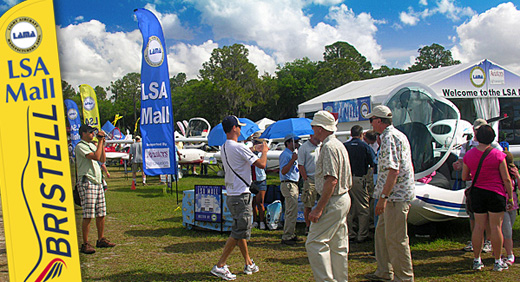
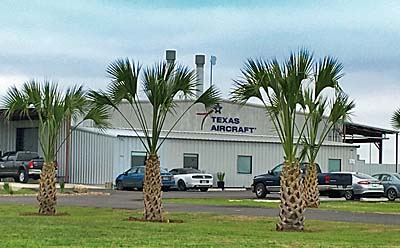 In late February, Texas Aircraft invited me to an unveiling ceremony. As it's always wonderful to witness the arrival of a new aircraft and sense the excitement and enthusiasm of its developers, I jumped at the opportunity.
Now that they've taken off the wraps, I am pleased to offer readers a first close look at the Colt 100.
In late February, Texas Aircraft invited me to an unveiling ceremony. As it's always wonderful to witness the arrival of a new aircraft and sense the excitement and enthusiasm of its developers, I jumped at the opportunity.
Now that they've taken off the wraps, I am pleased to offer readers a first close look at the Colt 100.
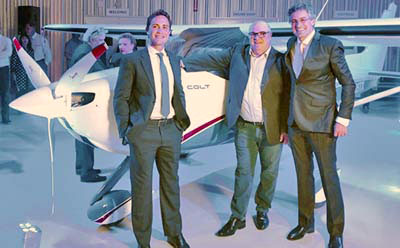
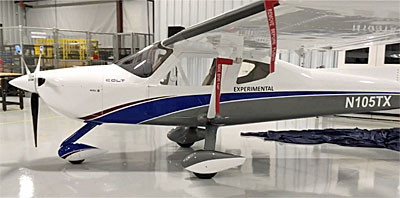 “We cannot thank the people of Hondo enough for the loving welcome we have received since coming here,” Barros said. “The leadership and people of Hondo have made this possible. We are proudly genuine sons and daughters of Hondo. We are confident that we will make Hondo deeply proud of us.”
“We cannot thank the people of Hondo enough for the loving welcome we have received since coming here,” Barros said. “The leadership and people of Hondo have made this possible. We are proudly genuine sons and daughters of Hondo. We are confident that we will make Hondo deeply proud of us.”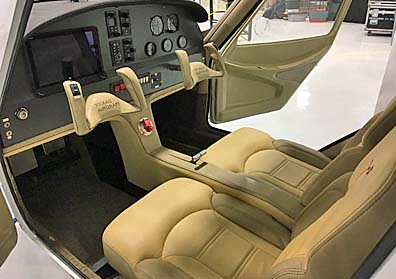 In addition to Hondo city officials including the mayor, Lyndsey Dennis represented Texas Governor Gregg Abbott’s Office of Economic Development and presented a certificate signed by the Governor congratulating the Texas Aircraft Manufacturing team with their accomplishment
In addition to Hondo city officials including the mayor, Lyndsey Dennis represented Texas Governor Gregg Abbott’s Office of Economic Development and presented a certificate signed by the Governor congratulating the Texas Aircraft Manufacturing team with their accomplishment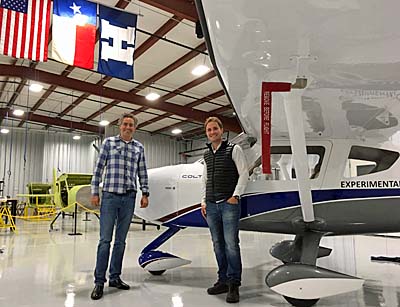 Powered by a Rotax 912 swinging a Sterno composite prop, Colt is an all-metal, tricycle gear design based on a previous-generation aircraft that
Powered by a Rotax 912 swinging a Sterno composite prop, Colt is an all-metal, tricycle gear design based on a previous-generation aircraft that 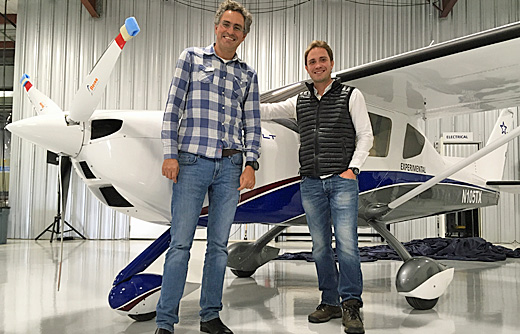
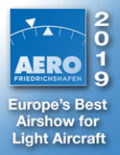 Something old. Something new. Hang glider pilots I know are very familiar with Horten designs, a form of validation for modern hang gliders …flying wings, aircraft with no tail or fuselage structures. Yet many pilots don't know Horton and have only a sketchy understand of flying wing stability.
Something old. Something new. Hang glider pilots I know are very familiar with Horten designs, a form of validation for modern hang gliders …flying wings, aircraft with no tail or fuselage structures. Yet many pilots don't know Horton and have only a sketchy understand of flying wing stability.
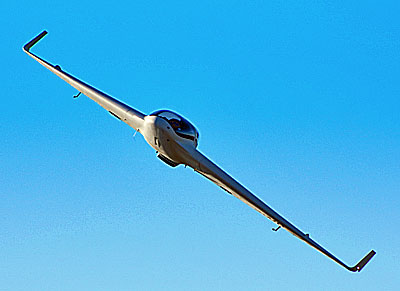 In 1943, Reichsmarschall Göring issued a request for design proposals to produce a bomber that was capable of carrying a 1,000 kilogram (2,200 pound) load over 1,000 kilometers (620 miles) at 1,000 kilometers per hour (620 mph) — the so-called "3×1000 project." Conventional German bombers could reach Allied command centers in Great Britain, but were suffering devastating losses from Allied fighters.
At the time, no aircraft could meet these goals. Junkers turbojet engines could provide the required speed but had excessive fuel consumption.
Walter and Reimer Horten concluded that a low-drag flying wing design could meet all of the goals. By reducing drag, cruise power could be lowered to the point where the range requirement could be met. They put forward their private project, the H.IX, as the basis for the bomber.
In 1943, Reichsmarschall Göring issued a request for design proposals to produce a bomber that was capable of carrying a 1,000 kilogram (2,200 pound) load over 1,000 kilometers (620 miles) at 1,000 kilometers per hour (620 mph) — the so-called "3×1000 project." Conventional German bombers could reach Allied command centers in Great Britain, but were suffering devastating losses from Allied fighters.
At the time, no aircraft could meet these goals. Junkers turbojet engines could provide the required speed but had excessive fuel consumption.
Walter and Reimer Horten concluded that a low-drag flying wing design could meet all of the goals. By reducing drag, cruise power could be lowered to the point where the range requirement could be met. They put forward their private project, the H.IX, as the basis for the bomber.
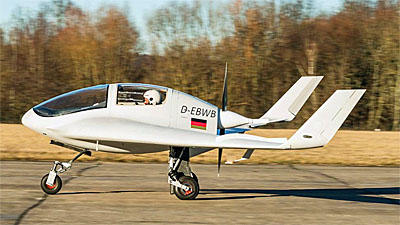 The Government Air Ministry approved the Horten proposal, but ordered the addition of two 30-mm cannons because they felt the aircraft would also be useful as a fighter as its estimated top speed was significantly higher than that of any Allied aircraft.
In short, flying wings are lean and make efficient use of the weight of their structure. That sounds like worthy qualifications for a Light-Sport Aircraft or Sport Pilot kit.
The Government Air Ministry approved the Horten proposal, but ordered the addition of two 30-mm cannons because they felt the aircraft would also be useful as a fighter as its estimated top speed was significantly higher than that of any Allied aircraft.
In short, flying wings are lean and make efficient use of the weight of their structure. That sounds like worthy qualifications for a Light-Sport Aircraft or Sport Pilot kit.
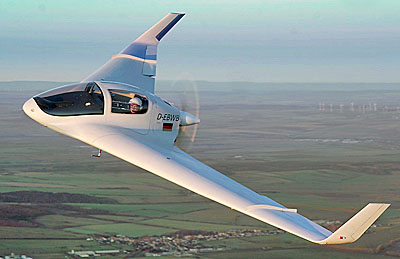
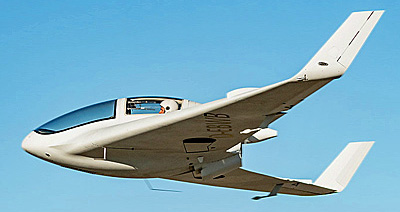 At this time, the company is not disclosing any pertinent data about the aircraft but I will be at
At this time, the company is not disclosing any pertinent data about the aircraft but I will be at 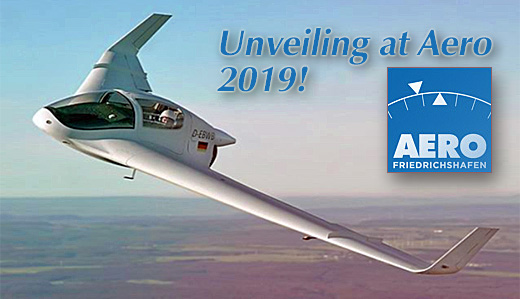
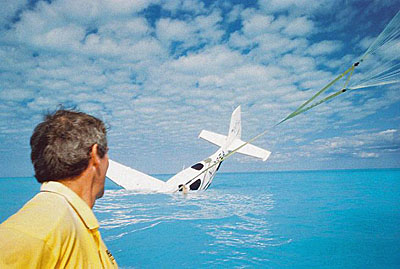 "You just saved my life!" It's not often anyone, even a medical doctor, hears those words. Back in the '90s I was sometimes on the receiving end of a call when a pilot phoned BRS to report a "save," a sparing of a life by the use of a parachute. It is a humbling experience to have someone exclaim that you (and your fellow workers) are the reason they are alive.
A few days ago, it happened again, for the 400th time.
"You just saved my life!" It's not often anyone, even a medical doctor, hears those words. Back in the '90s I was sometimes on the receiving end of a call when a pilot phoned BRS to report a "save," a sparing of a life by the use of a parachute. It is a humbling experience to have someone exclaim that you (and your fellow workers) are the reason they are alive.
A few days ago, it happened again, for the 400th time. 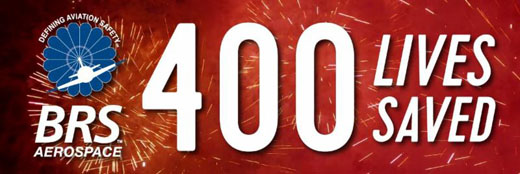 The system is designed to be a last resort for pilots and passengers when all other attempts to recover the airplane in case of emergency or pilot incapacitation have failed.
Numbers 400 and 401 entered the BRS save logbook when the pilot of a Cirrus aircraft with an engine out deployed the whole aircraft rescue system over water more than 20 miles from Grand Turk Island in the Turks and Caicos. BRS reported that pilot and passenger were uninjured and that they were picked up by a cruise ship.
The system is designed to be a last resort for pilots and passengers when all other attempts to recover the airplane in case of emergency or pilot incapacitation have failed.
Numbers 400 and 401 entered the BRS save logbook when the pilot of a Cirrus aircraft with an engine out deployed the whole aircraft rescue system over water more than 20 miles from Grand Turk Island in the Turks and Caicos. BRS reported that pilot and passenger were uninjured and that they were picked up by a cruise ship.

 Numerous European and U.S. ultralight and experimental aircraft use the system, including Lancair, Carbon Cub, Kitfox, Glassair,
Numerous European and U.S. ultralight and experimental aircraft use the system, including Lancair, Carbon Cub, Kitfox, Glassair, 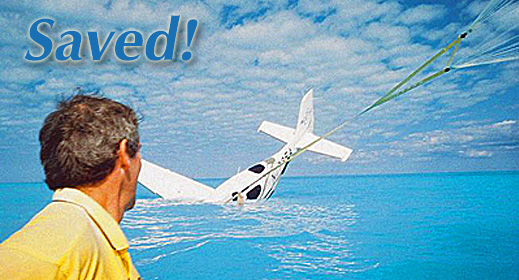
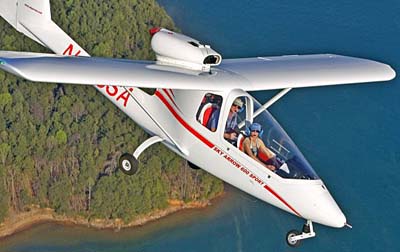 Light-Sport Aircraft have accomplished much in the 15 years this new class of aircraft have existed:
Light-Sport Aircraft have accomplished much in the 15 years this new class of aircraft have existed: 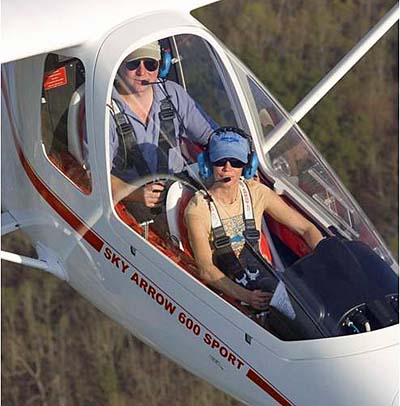 "Our new training partnership with
"Our new training partnership with 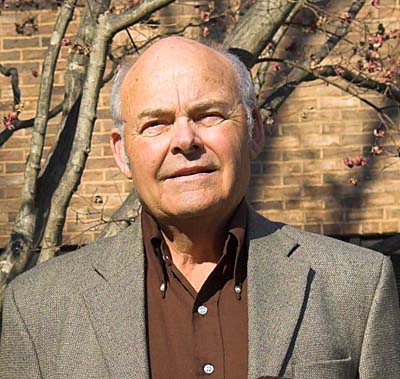 "It is safe to say that Able Flight would never have existed without the influence of
"It is safe to say that Able Flight would never have existed without the influence of 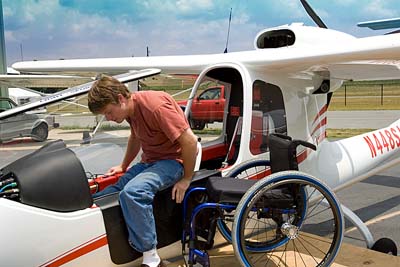 Jon passed away on February 15th at the age of 83. Aviation lost a good man after many productive years. Rest in peace, old friend.
Jon and Ron, twin brothers like Jon's sons Mike and Mitch, last year made another donation, this one to Mt. Vernon Airport, home of the
Jon passed away on February 15th at the age of 83. Aviation lost a good man after many productive years. Rest in peace, old friend.
Jon and Ron, twin brothers like Jon's sons Mike and Mitch, last year made another donation, this one to Mt. Vernon Airport, home of the 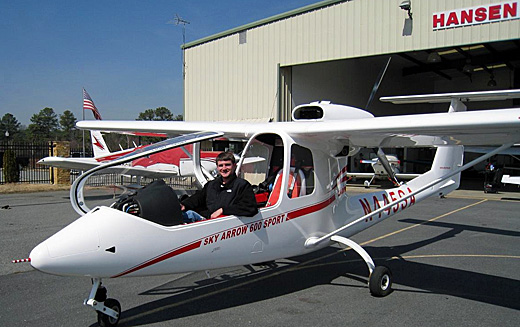
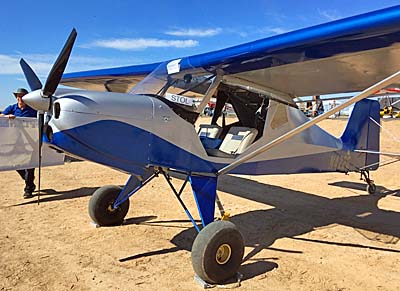 "We are Arizona's newest aircraft manufacturer," said Garrett Komm when we finally located him and his bright blue and silver aircraft.
A fan of this particular flying machine had approached me at Copperstate and said, "You gotta go see this airplane. Tell him Russell sent you!" (Thanks, Russell!)
After wrapping up a couple other video interviews, Videoman Dave and I left the main exhibit area to seek out Russell's discovery. As we came upon it, parked among other transients to the light aircraft area at Copperstate, we both found it vaguely familiar. Well, it was vague for me. Dave was sure right away.
That's because
"We are Arizona's newest aircraft manufacturer," said Garrett Komm when we finally located him and his bright blue and silver aircraft.
A fan of this particular flying machine had approached me at Copperstate and said, "You gotta go see this airplane. Tell him Russell sent you!" (Thanks, Russell!)
After wrapping up a couple other video interviews, Videoman Dave and I left the main exhibit area to seek out Russell's discovery. As we came upon it, parked among other transients to the light aircraft area at Copperstate, we both found it vaguely familiar. Well, it was vague for me. Dave was sure right away.
That's because 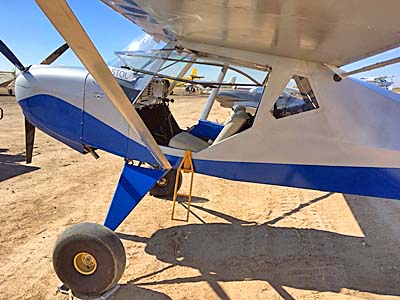
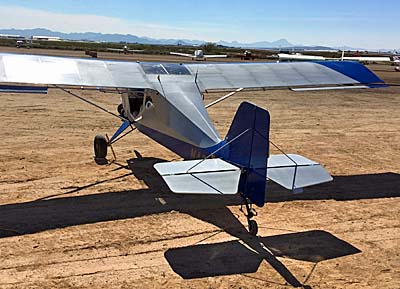 "Merlin was one tough little aeroplane," said Dave Loveman. "John Burch was a Canadian ultralight instructor and needed a better aircraft for his flight school. The 42 inch wide cabin is quite comfortable for even the largest of pilots." Mule is a bit wider at 46 inches.
After Burch's Canadian operation, Merlin was for a period offered by AeroComp on Florida's Atlantic coast, at the Merritt Island airport. Now Gair-Planes is offering the kit from Arizona, all part of the interesting migration of designs that prove their worth.
As with Merlin, Mule is built around a welded 4130 chromoly steel fuselage and tail structure, all fabric covered. Wings use aluminum D Cell construction, with styrofoam ribs. The result was tested by the Canadian creator to +4 and –2 Gs.
"Merlin was one tough little aeroplane," said Dave Loveman. "John Burch was a Canadian ultralight instructor and needed a better aircraft for his flight school. The 42 inch wide cabin is quite comfortable for even the largest of pilots." Mule is a bit wider at 46 inches.
After Burch's Canadian operation, Merlin was for a period offered by AeroComp on Florida's Atlantic coast, at the Merritt Island airport. Now Gair-Planes is offering the kit from Arizona, all part of the interesting migration of designs that prove their worth.
As with Merlin, Mule is built around a welded 4130 chromoly steel fuselage and tail structure, all fabric covered. Wings use aluminum D Cell construction, with styrofoam ribs. The result was tested by the Canadian creator to +4 and –2 Gs.
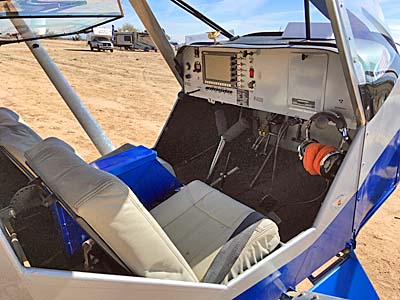 Mule is a taildragger, in a tractor configuration, with side by side seating. Controls are standard stick and rudder with a center Y-stick.
"We are not the fastest airplane out there," observed Garrett, "but we believe that we are one of the best for low and slow backcountry flying."
Powered by a
Mule is a taildragger, in a tractor configuration, with side by side seating. Controls are standard stick and rudder with a center Y-stick.
"We are not the fastest airplane out there," observed Garrett, "but we believe that we are one of the best for low and slow backcountry flying."
Powered by a 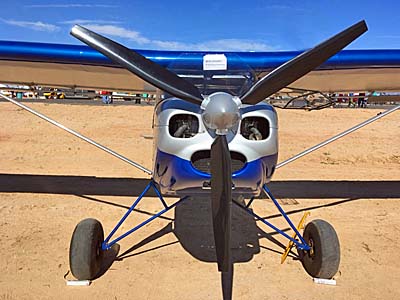 With an airframe kit price of $18,700, adding an engine for a similar amount, plus paint and basic avionics, you should be able to get a Mule airborne for less than $50,000.
"Building time is about 400 hours," said Garrett, though agreeing that this can depend on builder experience and how detailed the builder wants to go.
With an airframe kit price of $18,700, adding an engine for a similar amount, plus paint and basic avionics, you should be able to get a Mule airborne for less than $50,000.
"Building time is about 400 hours," said Garrett, though agreeing that this can depend on builder experience and how detailed the builder wants to go.
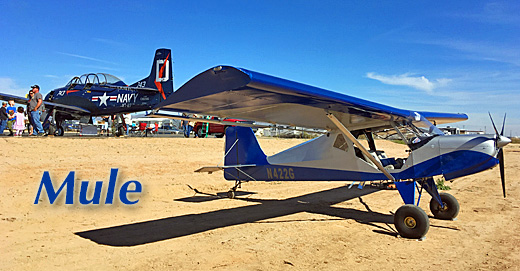
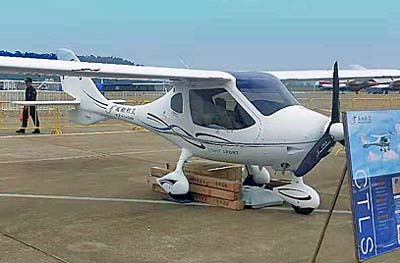 At a major show in China called Zhuhai visitors saw something: a new 6-axis LSA flight simulator. The developer is
At a major show in China called Zhuhai visitors saw something: a new 6-axis LSA flight simulator. The developer is 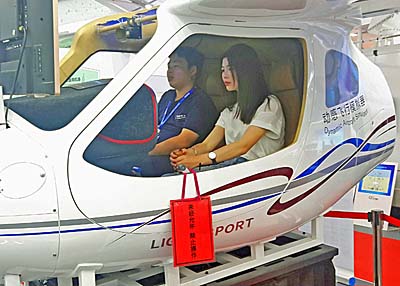 Chinese citizens play games, including flight simulators, as much as (or perhaps even more than) Americans do. Sitting at their computer or using a mobile smartphone or tablet is commonplace.
They know this activity and it may provide a bridge to people going aloft in an actual airplane like CTLS.
Imagine if you had never, ever seen a small plane of any kind. Would you rush to fly it? It's hard for Americans to envision this situation as we have small airplanes everywhere and airports in nearly every town in the nation.
AeroJones may truly be on to something developing their full-motion simulator.
“At the Zhuhai Airshow 2018, our AeroJones 6-axis of motion CTLS simulator was shown for the first time to the public,” said Michael Chou, who handles marketing for the company. He reported that reception to the new simulator was very enthusiastic.
Chinese citizens play games, including flight simulators, as much as (or perhaps even more than) Americans do. Sitting at their computer or using a mobile smartphone or tablet is commonplace.
They know this activity and it may provide a bridge to people going aloft in an actual airplane like CTLS.
Imagine if you had never, ever seen a small plane of any kind. Would you rush to fly it? It's hard for Americans to envision this situation as we have small airplanes everywhere and airports in nearly every town in the nation.
AeroJones may truly be on to something developing their full-motion simulator.
“At the Zhuhai Airshow 2018, our AeroJones 6-axis of motion CTLS simulator was shown for the first time to the public,” said Michael Chou, who handles marketing for the company. He reported that reception to the new simulator was very enthusiastic.
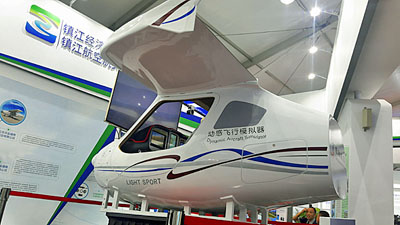
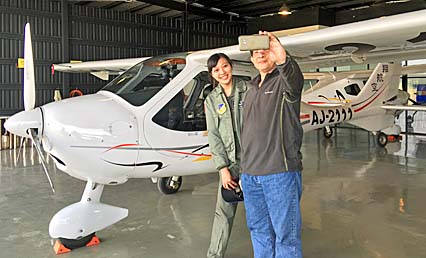 AeroJones is deep into planning for their new aircraft factory in Zhenjiang, China — where, presumably, they will also build the simulator. With the new facility, all manufacturing steps will be easier, less costly, and much more efficient, which will contribute to better values for customers buying the CTLS. Flight schools or other buyers of the modern and sophisticated CTLS will be able to fly to Dalu General Airport to see the factory and take demonstrations flights to confirm their purchase.
At the time the new factory was announced, Mr. Jones Chen said, “We are very pleased about the relationship with leaders of Zhenjiang. We look forward to a long and prosperous relationship."
AeroJones is deep into planning for their new aircraft factory in Zhenjiang, China — where, presumably, they will also build the simulator. With the new facility, all manufacturing steps will be easier, less costly, and much more efficient, which will contribute to better values for customers buying the CTLS. Flight schools or other buyers of the modern and sophisticated CTLS will be able to fly to Dalu General Airport to see the factory and take demonstrations flights to confirm their purchase.
At the time the new factory was announced, Mr. Jones Chen said, “We are very pleased about the relationship with leaders of Zhenjiang. We look forward to a long and prosperous relationship."

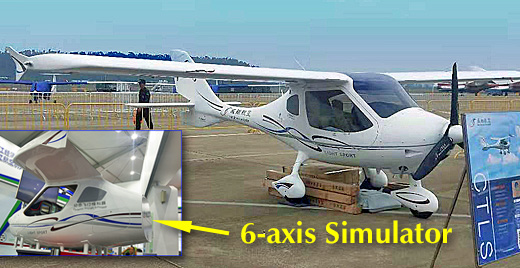
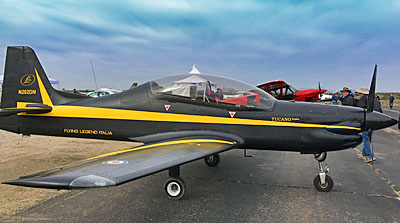 On Day 3 of
On Day 3 of 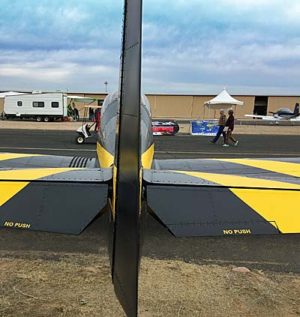 Flying Legend's Tucano is a scale replica of well-regarded original. Embraer's EMB 312 Tucano is "a low-wing, tandem-seat, single-turboprop, basic trainer with counter-insurgency capability developed in Brazil," according to
Flying Legend's Tucano is a scale replica of well-regarded original. Embraer's EMB 312 Tucano is "a low-wing, tandem-seat, single-turboprop, basic trainer with counter-insurgency capability developed in Brazil," according to 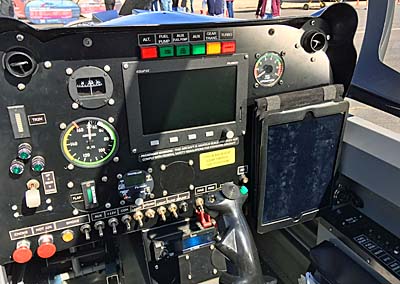 Stalls were surprisingly slow considering how clean the aircraft looks, down into the high 40 knot range. A LSA version should readily meet standards for stall.
Handling was very well behaved. I found the stick a mite heavy in roll but it was exceptionally precise. Again smooth air helps but Tucano held even steeply banked 720 turns with ease and a light touch. Trimming was not necessary to hold altitude, even in 45-degree banks.
Slow flight was easily controllable suggesting landing would be very manageable. It was and my first touchdown showed this Tucano has very good manners.
Throughout all maneuvers, visibility is glorious, a panorama in any direction except straight down. From the aft seat the wing blocked my downward view though it looked better from the front seat where you solo. The downside to that expanse of acrylic is heating in the summer in places like Texas, where Flying Legend USA is based. Additional air inlets are in the works.
Stalls were surprisingly slow considering how clean the aircraft looks, down into the high 40 knot range. A LSA version should readily meet standards for stall.
Handling was very well behaved. I found the stick a mite heavy in roll but it was exceptionally precise. Again smooth air helps but Tucano held even steeply banked 720 turns with ease and a light touch. Trimming was not necessary to hold altitude, even in 45-degree banks.
Slow flight was easily controllable suggesting landing would be very manageable. It was and my first touchdown showed this Tucano has very good manners.
Throughout all maneuvers, visibility is glorious, a panorama in any direction except straight down. From the aft seat the wing blocked my downward view though it looked better from the front seat where you solo. The downside to that expanse of acrylic is heating in the summer in places like Texas, where Flying Legend USA is based. Additional air inlets are in the works.
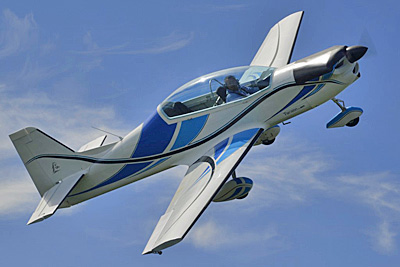

 Let me be fair. Other West Coast aviation events have interesting qualities but none has ever risen to the level of AirVenture Oshkosh or Sun 'n Fun. Those two dominate general aviation events. Both are "back East."
With big pilot and aircraft populations in California, Arizona, and Washington, why have we no major shows in the West? No one I've asked can explain the riddle but could Copperstate Buckeye Air Fair be the right combination? Only time will tell yet on Saturday, crowds were as thick as Oshkosh, albeit in a much smaller area. City planners offered an airshow and lots for attendees to look at plus the Copperstate trade show alongside the Buckeye Air Fair gave the public close access to pilots operating all manner of light aircraft.
Let me be fair. Other West Coast aviation events have interesting qualities but none has ever risen to the level of AirVenture Oshkosh or Sun 'n Fun. Those two dominate general aviation events. Both are "back East."
With big pilot and aircraft populations in California, Arizona, and Washington, why have we no major shows in the West? No one I've asked can explain the riddle but could Copperstate Buckeye Air Fair be the right combination? Only time will tell yet on Saturday, crowds were as thick as Oshkosh, albeit in a much smaller area. City planners offered an airshow and lots for attendees to look at plus the Copperstate trade show alongside the Buckeye Air Fair gave the public close access to pilots operating all manner of light aircraft.
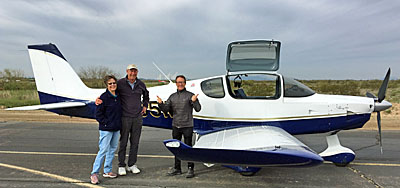 Serious airplane buyers encouraged vendors on Thursday before the public attended. They came out in huge droves on Saturday. Vice Mayor Eric Orsborn, whom I interviewed on video, estimated 15-20,000 people that day. It looked like it and we have video proof. By the way, Eric is not only a city leader, he's a pilot who just earned his ticket. His wife is also pursuing flying lessons and is going through ground school now.
If Sunday is equally strong, most will consider this pairing of city air fair with industry trade show to be a resounding success. Vice Mayor Eric said the city was very pleased about the link-up and sees good things in the future.
Serious airplane buyers encouraged vendors on Thursday before the public attended. They came out in huge droves on Saturday. Vice Mayor Eric Orsborn, whom I interviewed on video, estimated 15-20,000 people that day. It looked like it and we have video proof. By the way, Eric is not only a city leader, he's a pilot who just earned his ticket. His wife is also pursuing flying lessons and is going through ground school now.
If Sunday is equally strong, most will consider this pairing of city air fair with industry trade show to be a resounding success. Vice Mayor Eric said the city was very pleased about the link-up and sees good things in the future.
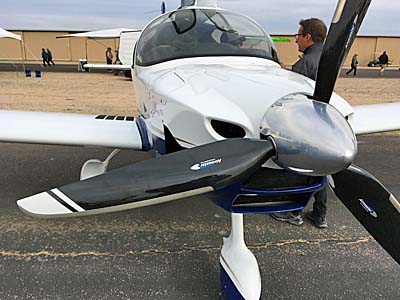 In two quickly linked flights, they let me compare 915 to 912iS. That was most helpful but I did not know either airframe well so it was challenging to compare performance with my earlier experiences. Now, I have a better picture.
At Copperstate a couple years ago I flew Sling 4 with Rotax's 914 Turbo. I was very impressed, feeling it flew as well as the Sling LSA. Dare I admit I actually liked the four seater's flight qualities better than the LSA?
Like Sling 4, Sling TSi is not a Light-Sport Aircraft. It cannot be flown with the Sport Pilot certificate. Several reasons explain why, even though the new model closely resembles the Sling LSA.
First, it's a four seater. Secondly, it has much higher power. That's allowed but the
In two quickly linked flights, they let me compare 915 to 912iS. That was most helpful but I did not know either airframe well so it was challenging to compare performance with my earlier experiences. Now, I have a better picture.
At Copperstate a couple years ago I flew Sling 4 with Rotax's 914 Turbo. I was very impressed, feeling it flew as well as the Sling LSA. Dare I admit I actually liked the four seater's flight qualities better than the LSA?
Like Sling 4, Sling TSi is not a Light-Sport Aircraft. It cannot be flown with the Sport Pilot certificate. Several reasons explain why, even though the new model closely resembles the Sling LSA.
First, it's a four seater. Secondly, it has much higher power. That's allowed but the 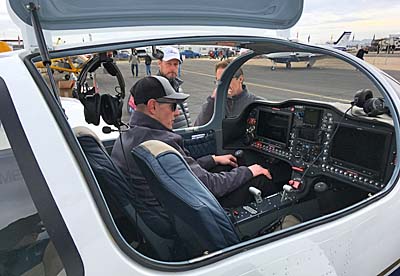 Acceleration was fast, we rolled less than 500 feet and climbed quickly from the start and kept going. Jean d'Assonville and I flew perhaps 300 pounds under gross but
Acceleration was fast, we rolled less than 500 feet and climbed quickly from the start and kept going. Jean d'Assonville and I flew perhaps 300 pounds under gross but 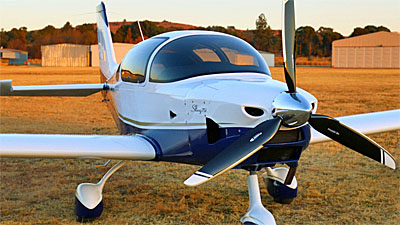 The wing itself is a fresh new airfoil and wingspan is about 16 inches shorter on each side.
The tailplane has counterbalanced surfaces to reduce chances of flutter given Sling TSi's speedier ways.
Aloft we saw 128 knots at modest cruise power and 3,500 feet MSL. Coming out to the show Jean and Wayne reported seeing better than 160 knots TAS and 180 knots GPS groundspeed, thanks to a tailwind. Fuel burn was a bit over six gallons an hour. Climb out of Buckeye (1,000 foot field elevation on a cool day) averaged 1,000 fpm and we saw 1,500-1,800 fpm on successive climbs from a touch and go.
The wing itself is a fresh new airfoil and wingspan is about 16 inches shorter on each side.
The tailplane has counterbalanced surfaces to reduce chances of flutter given Sling TSi's speedier ways.
Aloft we saw 128 knots at modest cruise power and 3,500 feet MSL. Coming out to the show Jean and Wayne reported seeing better than 160 knots TAS and 180 knots GPS groundspeed, thanks to a tailwind. Fuel burn was a bit over six gallons an hour. Climb out of Buckeye (1,000 foot field elevation on a cool day) averaged 1,000 fpm and we saw 1,500-1,800 fpm on successive climbs from a touch and go.
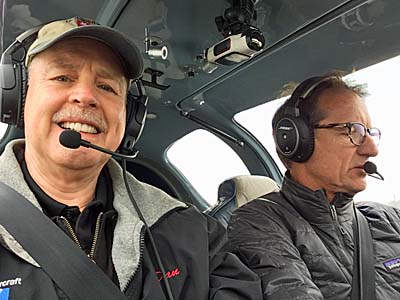 Stalls in all configurations were very mild, even with full stick aft and no quick effort of recovery. At full power, Sling TSi would not stall and only wobbled the nose to signal the pilot — well, that and a clearly audible stall warning plus a very steep deck angle.
Handling was very responsive but steady with a light touch even in steeply banked 720 turns. My efforts at dutch rolling produced acceptable results either fast or slow.
The landing was straightforward. Sling TSi manages energy very well — an LSA-like feel, it had — making roundout and touchdown quite easy. Visibility is good, a very good thing at a busy Buckeye Municipal (KBXK) when numerous airplanes entered the pattern to pay a visit.
In all, Sling TSi is a commendable achievement, a further refinement of the original Sling LSA introduced in 2009. In that decade, Sling has delivered more than 500 aircraft, Jean indicated.
We recorded a full Video Pilot Report with cameras on and in the airplane. When it's done in editing, this will provide much more detail and very few complaints about
Stalls in all configurations were very mild, even with full stick aft and no quick effort of recovery. At full power, Sling TSi would not stall and only wobbled the nose to signal the pilot — well, that and a clearly audible stall warning plus a very steep deck angle.
Handling was very responsive but steady with a light touch even in steeply banked 720 turns. My efforts at dutch rolling produced acceptable results either fast or slow.
The landing was straightforward. Sling TSi manages energy very well — an LSA-like feel, it had — making roundout and touchdown quite easy. Visibility is good, a very good thing at a busy Buckeye Municipal (KBXK) when numerous airplanes entered the pattern to pay a visit.
In all, Sling TSi is a commendable achievement, a further refinement of the original Sling LSA introduced in 2009. In that decade, Sling has delivered more than 500 aircraft, Jean indicated.
We recorded a full Video Pilot Report with cameras on and in the airplane. When it's done in editing, this will provide much more detail and very few complaints about 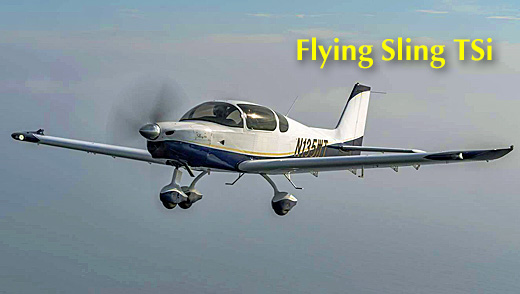
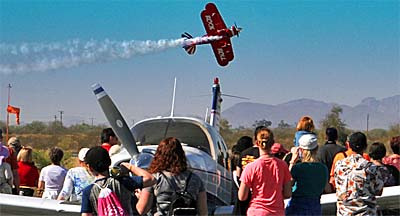 The Copperstate airshow is on in Arizona! Put on by a new combination of Copperstate leadership in cooperation with the town of Buckeye Arizona — which has been hosting its own
The Copperstate airshow is on in Arizona! Put on by a new combination of Copperstate leadership in cooperation with the town of Buckeye Arizona — which has been hosting its own 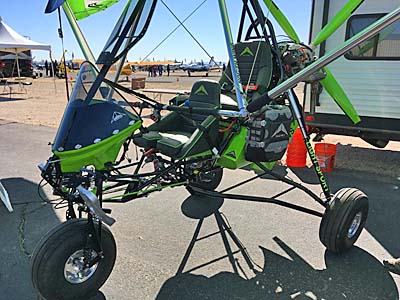 In many years of reporting on light aircraft, I have flown a lot of weight shift control trikes. I love flying trikes. I've flown simple ones, super-deluxe ones, tough ones, and ones that weren't so tough. Most I enjoyed.
Yet I've never seen one built so sturdily as
In many years of reporting on light aircraft, I have flown a lot of weight shift control trikes. I love flying trikes. I've flown simple ones, super-deluxe ones, tough ones, and ones that weren't so tough. Most I enjoyed.
Yet I've never seen one built so sturdily as 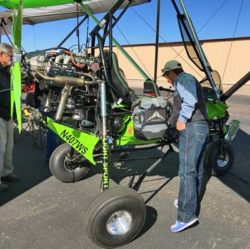 "Talk about heavy-duty, this is simply the roughest, toughest Weight Shift Control (WSC) trike in the world," said Sid. After my own close look at Goat, I cannot dispute his description.
"Our impact testing exceeded 6 feet high at maximum gross weight in several configurations & trajectories," explained Denny. ASTM requires that a trike be dropped in various ways including nosewheel first …but from 16 inches, not six feet. I've seen these kinds of tests; they are very demanding of an airframe.
"Finally," Denny added, "we focused on short take off & landing (STOL) with emphasis on being easy to setup & transport coupled with “easy-to-fly.”
"Talk about heavy-duty, this is simply the roughest, toughest Weight Shift Control (WSC) trike in the world," said Sid. After my own close look at Goat, I cannot dispute his description.
"Our impact testing exceeded 6 feet high at maximum gross weight in several configurations & trajectories," explained Denny. ASTM requires that a trike be dropped in various ways including nosewheel first …but from 16 inches, not six feet. I've seen these kinds of tests; they are very demanding of an airframe.
"Finally," Denny added, "we focused on short take off & landing (STOL) with emphasis on being easy to setup & transport coupled with “easy-to-fly.”
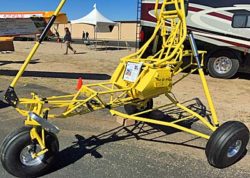 "Goat is one of a kind, said Denny. "It doesn’t need special care. It is not fragile. It just needs good fuel, your respect, and a little love once in a while. If anybody can build something better, we’d like to be your first customers. Until then, we’re looking to build our team of true adventurers. We hope to share what we’ve learned & hope to learn from you too."
"After all, aviation is not about the planes, it’s about what you do with them." Who can argue with Reed's logic?
Here's a quick (2-minute) teaser video about Goat:
https://youtu.be/zBwU02qt2xQ
"Goat is one of a kind, said Denny. "It doesn’t need special care. It is not fragile. It just needs good fuel, your respect, and a little love once in a while. If anybody can build something better, we’d like to be your first customers. Until then, we’re looking to build our team of true adventurers. We hope to share what we’ve learned & hope to learn from you too."
"After all, aviation is not about the planes, it’s about what you do with them." Who can argue with Reed's logic?
Here's a quick (2-minute) teaser video about Goat:
https://youtu.be/zBwU02qt2xQ